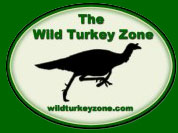When setting up on turkeys
before daylight, don't try to get too close
to a roost. Opinions vary on what the proper
distance is but as a general rule, try and
get within 100 - 150 yards if it's possible.
You're basically trying to get as close as
possible to the bird without scaring it off
the roost. The closer you are, the fewer the
obstacles that turkey will have to come around
to get to you.
Most turkey hunters have experienced
a tom that "hangs up" which simply
means he stops out of range at 60 yards or
more, is still gobbling and refuses to come
close enough for a shot. He may be hung up
for several reasons. He could be behind some
obstacle like a fence or creek, he might
be in his favorite strutting area or he has
some hens with him. He might also just be
stubborn and if you call to him a lot, he
will just stay there and wait for the "hen"
to come to him.
There are several things to
try when this happens. First, try using very
soft "clucks" and "purrs"
to entice him that last 20 yards. Another
alternative tactic is to lightly scratch the
leaves with your hand, imitating the sounds
of a turkey scratching the ground. If that
doesn't work, stop calling altogether and
wait him out. Turkeys have their own sense
of time and it's nothing for a gobbler to
stand and strut for an hour or so in the same
spot before finally giving into curiosity
and coming the rest of the way in.
If the bird is still far enough
away or hidden enough to allow you some limited
movement, try switching calls. And, finally,
the most risky option is to change your calling
location either by moving back 50 yards or
so and calling again there so the gobbler
thinks the hen is going away, or simply circling
the gobbler and trying to call him in from
a different direction.
If you have found a gobbler
that is located on a hillside or part way
up a ridge, try and climb the hill or ridge
and call from a position above the tom or
at least on the same level. Turkeys are not
as likely to come downhill to a call.
If you're lucky(?) enough
to live in a windy state like I do, you better
learn to hunt in the wind. Strong winds increase
the challenge of turkey hunting since you
cannot hear as well and neither can the turkeys.
Try and find spaces that are out of the wind
if possible and if not use loud, high-pitched
box calls and glass or aluminum friction calls
that can be heard through that wind. Try setting
up and calling in a position upwind of where
you think there may be turkeys so the sound
of your calling can go downwind to them.
Do not attempt to shoot a
strutting gobbler. If you can, wait until
the bird comes out of strut and extends his
neck. If he doesn't do it by himself, give
him a "cluck" or two and that is
usually enough for him to come out of strut
and raise his head to see who is there. Your
goal as a hunter is to take the best shot
possible and cleanly harvest the bird. A shotgun
pattern is most efficient when the bird extends
its neck, enlarging the target area.
Patience, Patience, Patience
- Probably the most overlooked skill in turkey
hunting is the ability to sit still and wait
out a gobbler. When you can't stand sitting
anymore and you think it's time to get up
and move to another hunting spot, stay put
for fifteen more minutes. Patience kills more
gobblers than any other factor.
If you see another hunter
approaching you in the woods, never move or
make turkey sounds. Simply call out his name
if you know him or say "Hello."
The sound of a human voice will safely alert
the hunter that someone else is in the area.
It is far better to maybe spook a gobbler
in the area than to get accidentally shot
at.

